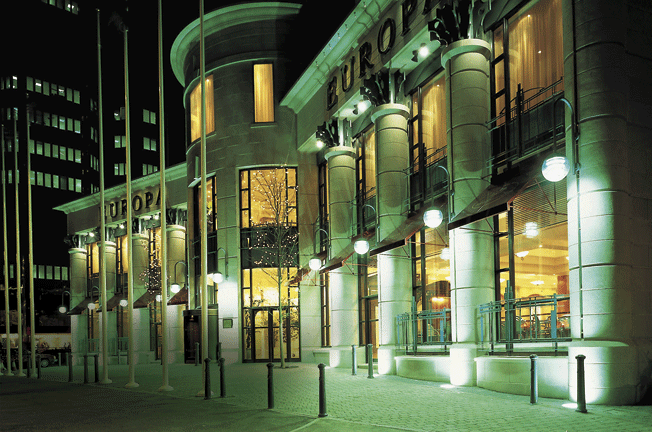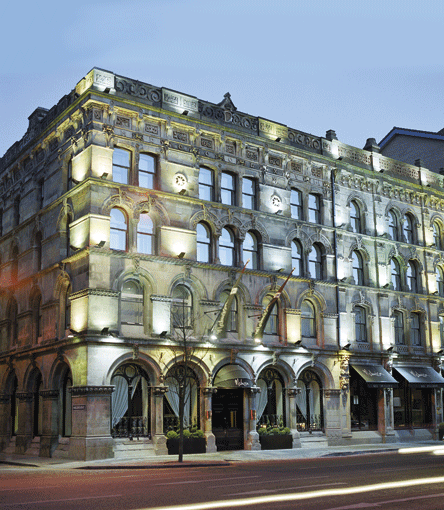

Belfast
Moves Beyond
 |
Restaurants with seasonal, organic menus; poetry readings and
an annual arts festival in the newly hip Cathedral Quarter; sleek architectural triumphs
like the Victoria Square retail complex with its glass-domed roof.
By Jill Fergus
This is the new Belfast. Once war-torn and economically depressed, the Northern Irish capital has steadily been righting its course – It recently celebrated the 10th anniversary of the Good Friday Agreement, which brought an official end to years of sectarian violence. And while the city is feeling the global economic pinch, there’s no going back to the dark days. The palpable excitement is particularly evident in the city’s buzzing hotel scene, where boutique properties with design-conscious interiors and a strong emphasis on customer service have given the city’s hospitality industry a major boost.
Opened last spring, the Fitzwilliam (www.fitzwilliamhotelbelfast.com; from $180), located next door to the Grand Opera House on Great Victoria Street, is the sister hotel to the Fitzwilliam in Dublin (two hours away by train). Christopher Ash, who designed the original hotel under Sir Terence Conran, takes the reins here, and his ultra-glam guest rooms feature boldly patterned custom carpets, lime green-and-chocolate brown color scheme and art deco-style lamps. Also courtesy of the Dublin property comes the culinary expertise of Michelin-starred chef Kevin Thornton, who oversees the food and beverage operations:
Expect updated Irish classics such as bacon and cabbage tureen with a shallot vinaigrette and leek puree and braised beef in sauce.
Another stylish option is Ten Square (www .tensquare.co.uk; from $150) in the heart of the city on Donegall Square across from City Hall, which is an imposing Renaissance-style tower. (On its ground sits a smaller version of the London Eye Ferris wheel, quickly becoming a beloved addition to the Belfast skyline.) Housed in an attractive Georgian mansion, the 23 contemporary rooms are outfitted with platform beds and modern artwork. The Grill Room crackles with a cosmopolitan crowd, especially during lunchtime – when the weather cooperates, the outdoor patio and nosh on duck rolls and Dundrum Bay prawns is a prime people-watching spot.
Just on the outskirts of the Cathedral Quarter, the former shipping and commercial center turned arts district, is the Malmaison (www.malmaison.com; from $242), a branch of the popular hotel chain with properties throughout the U.K., including those in Edinburgh and Liverpool.
Housed in an ornate limestone building – formerly a seed storage warehouse – the hotel features 62 guest rooms and interiors designed in dark woods and jewel tones. The Samson Suite with a purple snooker table and fireplace is a favorite of visiting celebrities and musicians.
A few blocks away in the former Ulster Bank headquarters is the stately Merchant Hotel (www.the merchanthotel.com; from $267), the city’s most exclusive hotel, opened in 2006 by Northern Irish entrepreneur Bill Wolsey. The architectural detailing throughout the 1860 building is nothing short of grand, particularly the 30-foot brass chandelier hanging from the stained-glass domed ceiling in the Main Banking Hall, which now serves as the restaurant.
Even if you don’t stay here be sure to book the afternoon tea served with finger sandwiches and freshly baked scones with clotted cream. Highlights of the 26 antiques-filled rooms include clawfoot bathtubs, crushed velvet headboards, and inlaid wooden chests. An expansion with 38 additional rooms and a spa is set to open later this year.
Even during the height of the Troubles in the 1970s, the Europa Hotel (www .hastingshotels.com; from $114) never closed its doors, and it played a role in the peace efforts as it hosted many dignitaries, including President Bill Clinton in 1995. Today, visitors will find 272 guest rooms decorated with Ralph Lauren fabrics, the casual Causerie bistro, and the Piano restaurant where you’ll hear jazz along with old Irish standards.